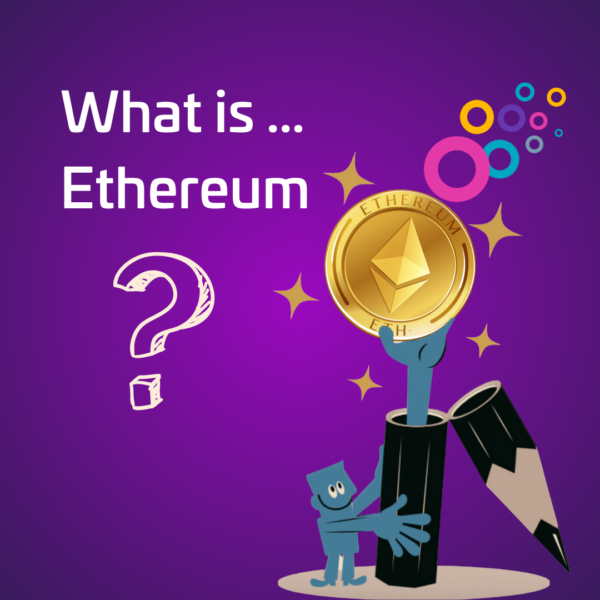
Our Cryptocurrrency guide highlights the common questions, "How does Ethereum work?" "Is Ethereum secure?" and "How to invest in Ethereum".
Ethereum is a decentralized smart contract platform that was first proposed in 2013 and launched one year later. A highly powerful network with a public blockchain as its base layer, Ethereum facilitates financial contracts, trustless asset exchange, and the creation and deployment of decentralized applications (dApps), particularly those that operate under the banner of decentralized finance (defi).
Ethereum’s native cryptocurrency, ether (ETH), is the second most valuable digital asset, with a market capitalization of over $200 billion and 24-hour volume of over $20 billion. Its ERC20 token standard, meanwhile, is the most popular in the industry.Though there is some common ground between Ethereum and its so-called rival Bitcoin, it’s fair to say the smart contract platform has its own aims and objectives. Its community of contributors and investors is also every bit as passionate as Bitcoin’s, with many contending that Ethereum is actually the most important platform in crypto – because it can power a fairer and more transparent financial system.
How Is Ethereum Different From Bitcoin?
In order to understand why Ethereum is valuable, it’s worth considering its key points of divergence from Bitcoin. But first, a similarity: both blockchains utilise an identical consensus protocol called Proof of Work (PoW), wherein miners determine the state of information on the network and protect it against malicious attacks.
Even this piece of common ground is crumbling, however. Ethereum has vocally committed to phasing out its Ethash Proof of Work system in favour of Proof of Stake (PoW), an overhaul that will eliminate energy-intensive mining from the smart contract platform. With PoS, users must stake their ETH to become validators on the network, whereafter they will be responsible for ordering transactions and creating new blocks, just like the miners of old.
Ethereum’s much-vaunted Eth2 upgrade, thanks to introduction of PoS and other efficiencies, is predicted to make the platform more scalable, more secure, and more environmentally sustainable. Time will tell.
Aside from their current usage of Proof of Work, and the fact that both decentralized digital currencies are eagerly traded, spent and handled by users around the world, Bitcoin and Ethereum are vastly different. While Bitcoin is principally a peer-to-peer form of electronic cash, Ethereum is a sophisticated ledger technology that supports endless use cases.
Thus, while Bitcoin is inarguably the industry’s most important asset, Ethereum is easily its most important network. Not only is Ethereum the dominant settlement layer in crypto, and the first to settle over $1 trillion in a year (2020), but a vast sprawl of Ethereum-based applications are shaking up industries such as finance, real estate, gambling, governance and gaming. Some believe that Ethereum could become the transaction settlement layer for – wait for it – all of the world’s markets.
As it currently stands, Ethereum is 2-5x faster than Bitcoin, processing 10-15 transactions per second (tps) compared to the latter’s 3-5. Ethereum also has its own programming language, Solidity, and uses smart contracts, self-executing code that fulfills agreements between two parties.
The Rise of Defi on Ethereum
In just seven years, Ethereum has established itself as a powerhouse of the cryptosphere, a diverse ecosystem with millions of users, tens of thousands of applications, and hundreds of billions of dollars flowing through the network on a daily basis. While many people hold ETH as a store of value in its own right, the platform is so much bigger than its native asset: it is at the centre of a burgeoning new financial system.
Ethereum is the network of choice for defi protocols – permissionless financial applications related to borrowing, lending, saving and trading. Although defi is often touted for its ability to deliver financial inclusion to 1.7 billion unbanked people, it has mostly been used for speculation to this point. Since early 2020, the defi space has attracted tens of billions of value through Ethereum-native protocols like Maker, Compound and Uniswap.
As well as featuring an ever-expanding galaxy of popular defi products, three-quarters of stablecoins are issued on the Ethereum blockchain, with the collective value of these surpassing that of ETH. Moreover, Ethereum facilitates approximately 85% of stablecoin transaction volume.
Stablecoins, also known as crypto dollars, are intrinsically important in crypto as they help traders lock in profits and hedge during periods of high volatility. Amazingly, over $1 trillion worth of stablecoins were transacted on Ethereum in 2020, with over half coming from Tether (USDT).
The smart contract platform is not without its detractors. Much of the motivation for Eth2 stems from ever-rising gas fees caused by heavy network congestion and clogged blockspace, which has caused some users to abandon Ethereum in favour of layer-two networks like Polygon and Binance Smart Chain. The fact that it can sometimes cost $100 in gas (denominated in Gwei, the smallest unit of ether) simply to swap from one token to another hampers Ethereum’s prospects of being accessible to casual users.
The future, as they say, is unwritten, and it is unclear to what extent Ethereum will make good on its lofty vision of a fairer, more transparent system. Much will depend on the success or failure of Ethereum 2.0, as well as the general evolution of the cryptoconomy and the regulatory outlook for defi and stablecoins. Based on its performance to date, however, the Ethereum community has ample grounds for optimism. Crypto simply wouldn’t be crypto without Ethereum.

